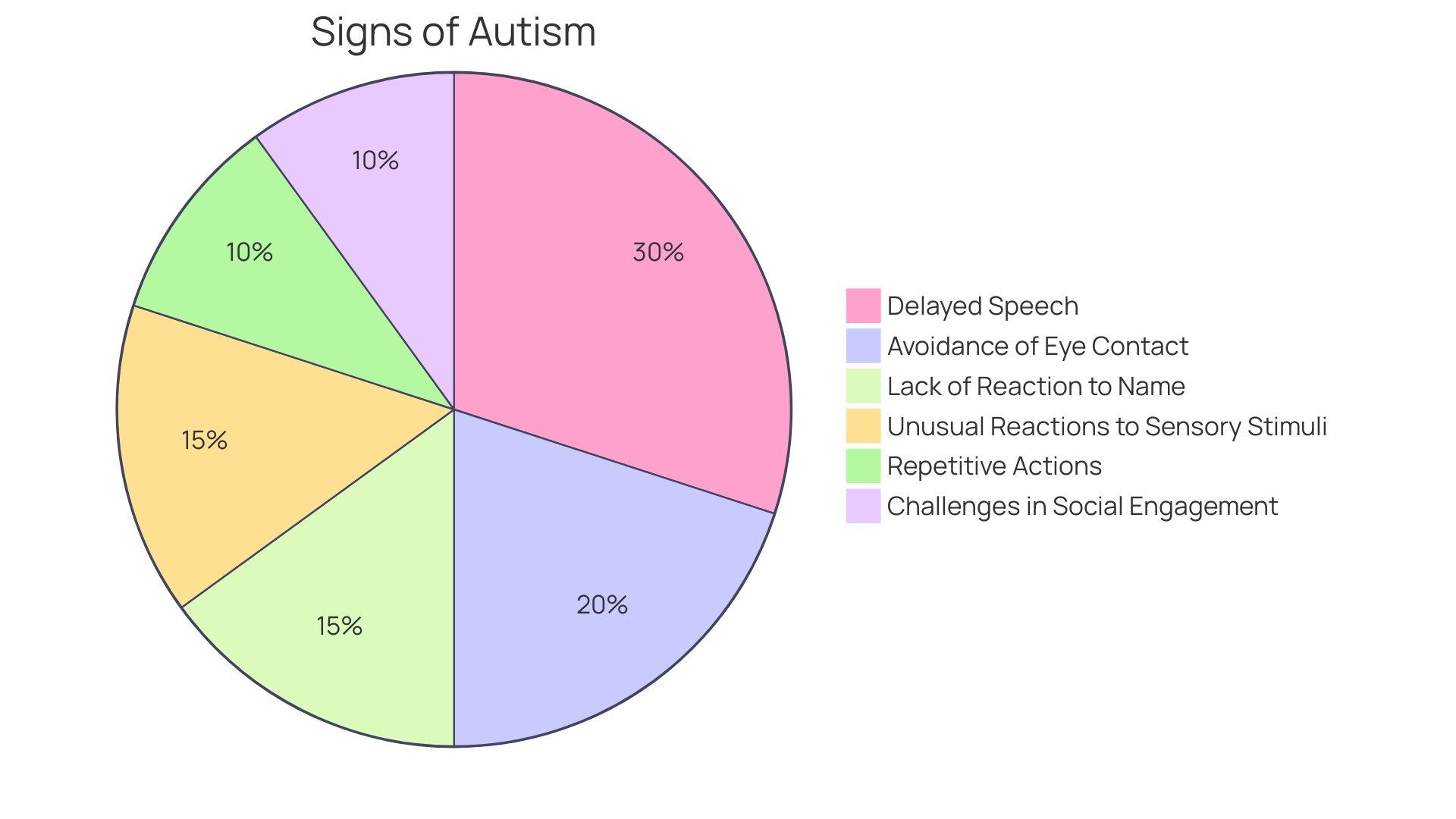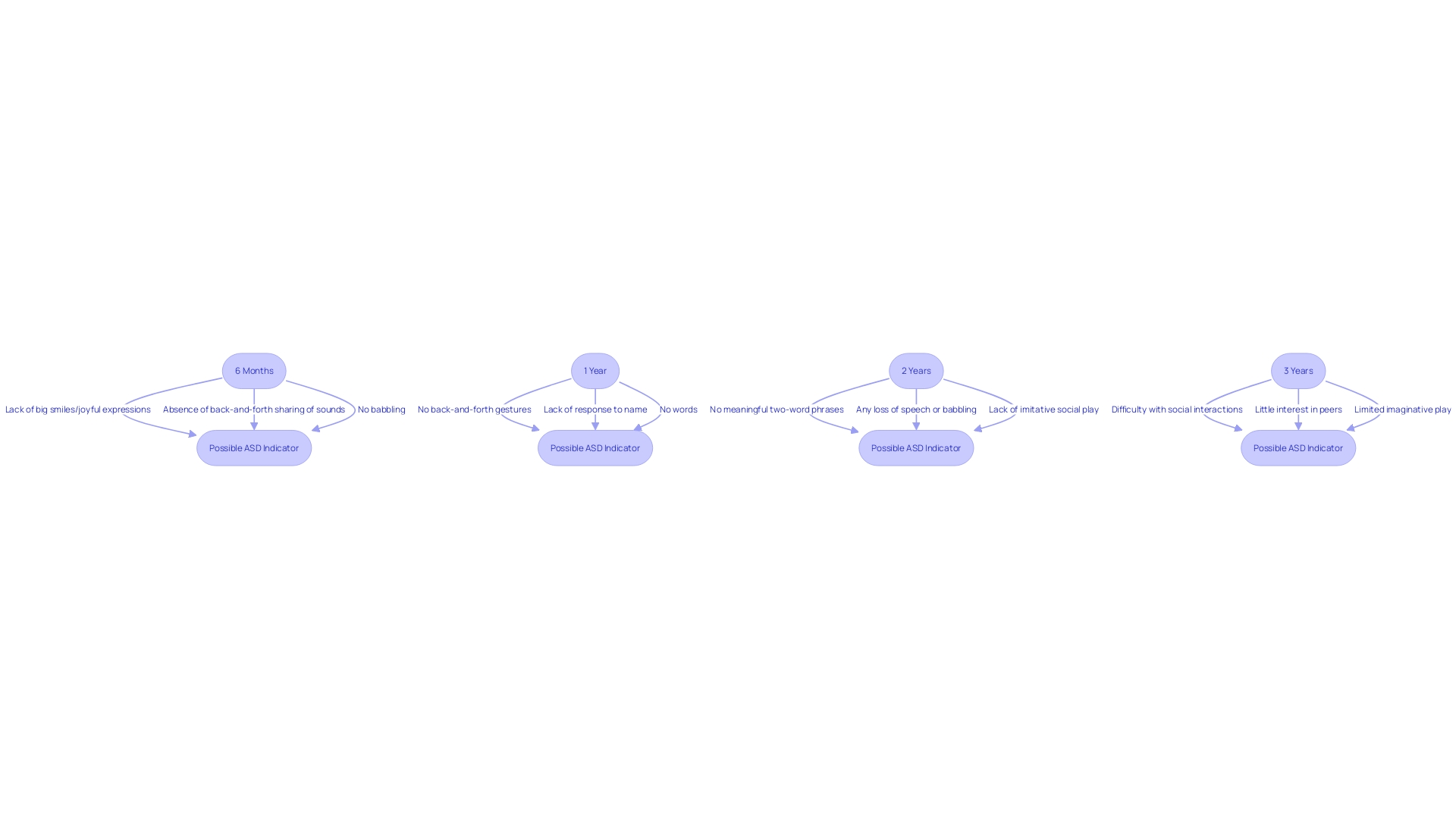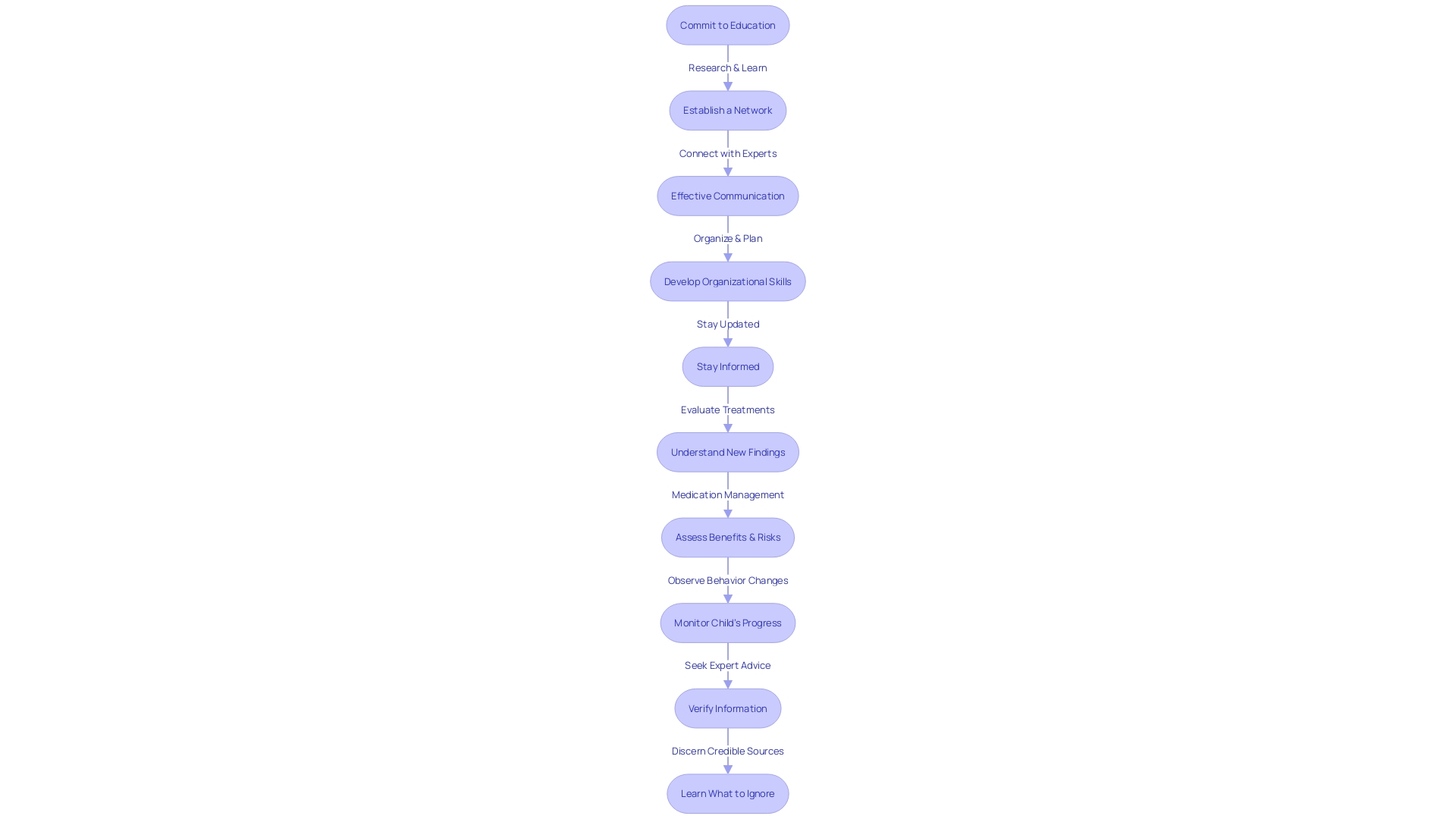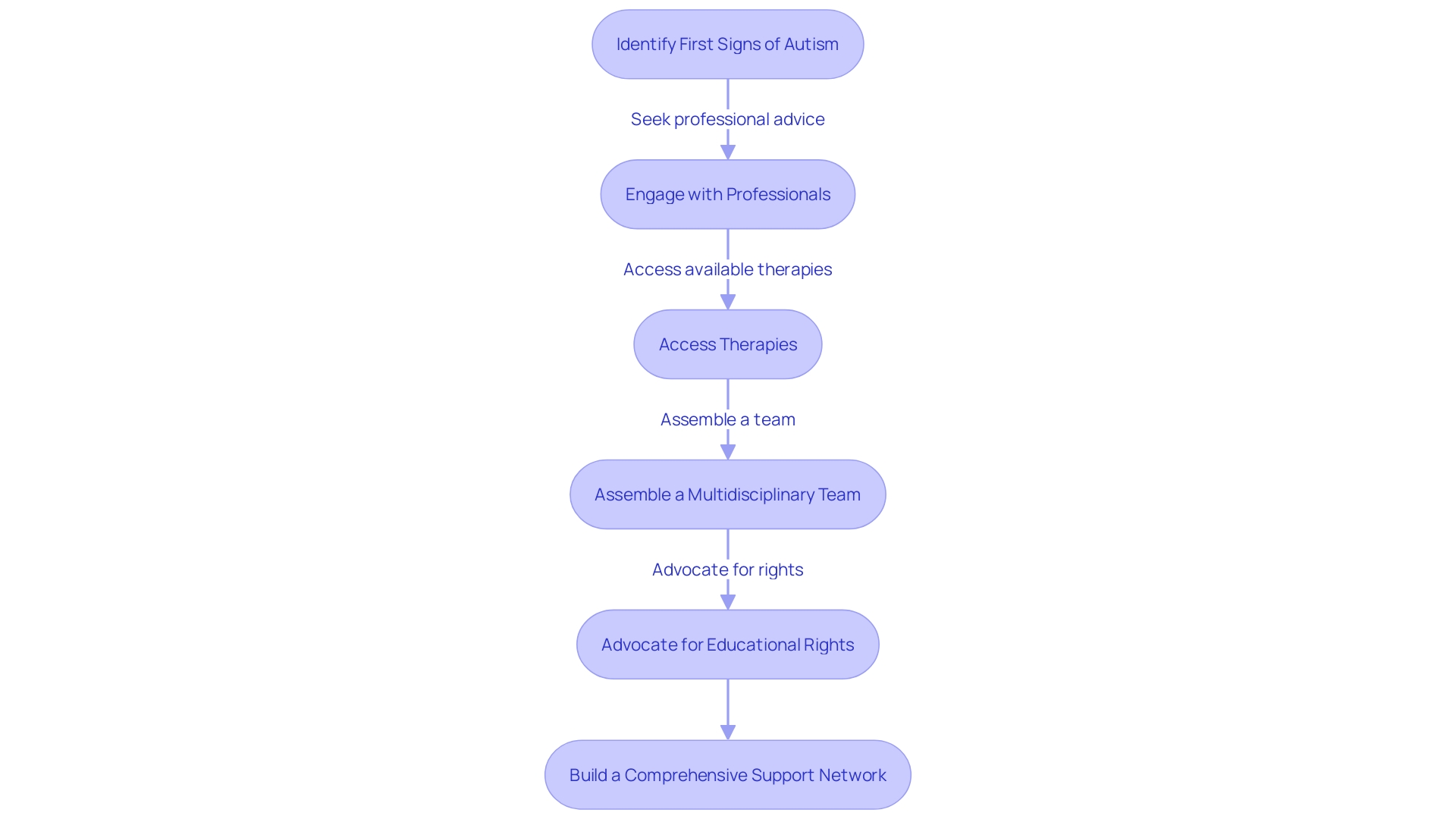Introduction
Spotting early signs of autism is crucial in providing support for children with this developmental disorder. The Autism Community in Action (TACA) and NeuroQure are two organizations committed to addressing the need for early and accurate diagnosis of Autism Spectrum Disorder (ASD). By providing resources and support, these organizations empower parents and professionals to identify early indicators of autism and seek out essential support and therapies promptly.
Additionally, inclusive early learning opportunities and individualized programming are emphasized to foster the development and well-being of children with autism. In this article, we will explore the importance of early recognition, common signs of autism in babies and toddlers, social communication challenges, restrictive and repetitive behaviors, developmental milestones to watch for, how to advocate for your child, screening and diagnostic tools, and the next steps after diagnosis. By understanding and addressing these topics, parent advocates can play a crucial role in ensuring the well-being and optimal outcomes for their children with autism.
Why Early Recognition Matters
Identifying initial indications of developmental disorder is a crucial measure in offering assistance for children with this developmental condition. Duke University professors Geraldine Dawson and Guillermo Sapiro have developed an innovative app called Sense to know that assists in detecting behaviors associated with a developmental disorder in toddlers. Through the use of an AI algorithm, this tool can assist parents and professionals in identifying initial signs of a developmental disorder, allowing them to promptly seek necessary support and therapies.
Additionally, the importance of prompt intervention in ASD is emphasized by the considerable difficulties encountered by individuals with ASD. These challenges include socializing and communication difficulties, as well as repetitive behaviors, which can lead to a considerable disability. In fact, only a small percentage of individuals diagnosed before the age of five can live independently as adults. Through appropriate intervention, nonetheless, there is a higher probability for individuals with autism to acquire essential life skills and reach their maximum potential.
The Autism Community in Action (TACA) and NeuroQure demonstrate a commitment to addressing the critical need for timely and accurate diagnosis of ASD. By offering resources and assistance, these organizations strive to initiate behavioral therapy as early as possible, improving results for children. The call for an approach based on the needs, as opposed to a system based on the diagnosis, is echoed by research that emphasizes the importance of identification and the provision of assistance without the delays of a formal diagnosis. Such an approach can prevent long-term issues like mental health problems and school exclusion, which are more prevalent in individuals who lack timely support for individuals with autism.
Inclusive learning opportunities are also crucial for individuals with disabilities, including those with autism spectrum disorder. Legal foundations and recommendations from the Individuals with Disabilities Education Act (IDEA) and other childhood programs stress the importance of individualized programming and resources for states, educators, and families to foster inclusion from the youngest ages. With these concerted efforts, the transition from recognizing risk to addressing the first symptoms of ASD can be managed more effectively, paving the way for optimal outcomes.
Common Signs of Autism in Babies and Toddlers
For parental advocates nurturing young individuals, early detection of autism is crucial. Autism can appear in different ways, and individuals as young as three may exhibit signs that warrant attention. Pay close attention to whether an individual avoids eye contact, does not react to their name, or exhibits delayed speech. Repetitive actions and unusual reactions to sensory stimuli are also indicators. Furthermore, individuals with ASD may experience challenges in social engagement. These signs are crucial for parent advocates to recognize, as they can lead to timely developmental assessments and interventions.
Incorporating children with developmental disorder into early childhood programs is vital, and it is supported by the Individuals with Disabilities Education Act (IDEA). Inclusion from the earliest ages is critical for their development and well-being. Top-notch, personalized programming and resources are accessible to assist individuals with disabilities, particularly those with autism spectrum disorder, in environments such as childcare centers, Head Start, and preschools.
Recent research underscores the importance of staying informed about new findings and approaches in autism. Caregivers should be knowledgeable about their offspring's treatments and medications, comprehending the implications and monitoring their impact. Learning disorders, often diagnosed in school-aged individuals, highlight the variability in developmental timelines and the need for personalized educational strategies.
Engagement in a young person's development is not just about identifying challenges but also about reinforcing positive growth. Structured tools, like those from the #TheFamilyFirm book, can help set family values and goals, empowering parents to make informed decisions. Public campaigns and global programs provide practical guidance to improve cognitive and vocabulary abilities in young individuals. For customized assistance, communication tools and granting additional time for comprehension can have a substantial impact on a youngster's daily existence. These resources and strategies together pave the way for a supportive and inclusive environment for individuals with autism spectrum disorder, aligning with Dr. David (Dan) R. Of ford's vision of a fair 'race' for all children.

Social Communication Challenges
Autism spectrum disorder (ASD) often presents challenges in social communication for young individuals. By the age of three, the signs can become more noticeable as individuals with autism may struggle not only with verbal expressions but also with nonverbal cues, which are crucial for social interaction. For instance, they might find it hard to maintain eye contact, take turns in conversation, or interpret body language and facial expressions. This can make it difficult for them to express their needs and feelings, and to understand those of others.
To bridge this gap, visual aids such as picture cards can be effective in helping individuals with ASD to communicate. These tools can provide a concrete way to express their thoughts and desires, making communication less abstract and more accessible. Additionally, structured social interaction, which can be provided in various community settings, is beneficial. For instance, programs such as the community-based cafe at Friends of St James Park in Southampton provide opportunities for autistic youth and children to participate in meaningful social interactions and cultivate essential life skills in a nurturing setting.
The significance of inclusive participation in all life domains—school, home, leisure—is acknowledged as a crucial element in the mental health and well-being of individuals with disabilities. Efforts like Emirates airline's rehearsal flying experiences cater to the unique needs of young individuals, allowing them to familiarize themselves with the travel process and to find comfort in what could otherwise be an overwhelming experience.
Parent advocates play a vital part in investigating and executing approaches that uphold the social communication abilities of their offspring with special needs. While new findings and therapeutic approaches are continuously emerging, it is vital for caregivers to stay informed and critically evaluate the benefits and risks of treatments and interventions. By doing so, they can foster a fair and supportive race for their offspring's development and inclusion in society.
Restrictive, Repetitive Behaviors (RRBs)
For individuals with autism, especially 3-year-olds, it is crucial to identify and address restrictive, repetitive behaviors (RRBs)—a characteristic of autism spectrum disorder. These RRBs can manifest as repetitive movements like hand-flapping or body rocking, a strict adherence to routines, an intense focus on specific subjects, and a strong resistance to change. Addressing these behaviors effectively is not merely about managing them; it is about fostering an environment that is structured and nurturing.
According to Dr. David (Dan) R. Offord, a psychiatrist who specializes in the mental health of young individuals, fair involvement in educational, home, and leisure activities is imperative for the well-being of all children, especially those with disabilities. It is about making 'the race fair' for every individual, and this includes reducing chronic stressors. For a child with a developmental disorder, who may also have co-occurring emotional and behavioral problems, creating a fair race means building a supportive framework that allows them to thrive in their daily life.
The IACC, a federal advisory committee focused on advancing autism research and services, emphasizes the importance of collaboration between federal agencies and the autism community to improve quality of life for those on the spectrum. Likewise, the Kevin and Avonte Program, which has granted $10.3 million to initiatives aimed at preventing wandering incidents among those with developmental disabilities, highlights the significance of proactive community assistance and training to manage such challenges effectively.
In practical terms, caregivers can validate their young one's feelings during stressful situations by acknowledging their emotions and helping them tap into their strengths to cope. For instance, saying, 'You seem really frustrated or angry right now, is that right?' can create a sense of safety and understanding, paving the way for problem-solving and development of long-term coping skills.
Additionally, it is crucial to take into account the individual requirements and abilities of every young person, along with the support systems that parents need to facilitate their growth. As almost 20% of the population is covered by Medicaid, and many individuals with autism spectrum disorder qualify based on their disability, state Medicaid programs have a crucial role in providing access to care and services tailored to the autism community.
Establishing a supportive and structured environment for an individual with autism involves recognizing the uniqueness of their experience and the particular obstacles they encounter, as well as utilizing community and governmental resources to guarantee their complete and equitable participation in all aspects of life.
Developmental Milestones to Watch For
To effectively support the development of 3-year-olds, it's crucial for individuals involved in a young one's growth to understand the key milestones expected at this age. As every individual develops differently, there are shared signs in language, social engagement, cognitive functioning, motor abilities, and everyday tasks that indicate their advancement. Recognizing these signs is not about measuring a person's abilities against a rigid standard but about identifying their unique developmental trajectory. For example, as the research conducted by the University of York pointed out, young individuals possess an inherent capacity to impact their environment, which subsequently cultivates their genetic tendencies.
Furthermore, neuroscience research highlights the significance of early childhood as a crucial stage for brain development, with experiences during this period greatly influencing a young individual's future abilities. As young minds are particularly receptive, it's crucial to monitor the individual's development keenly. Observing how an individual interacts with their environment, such as identifying objects, discerning sizes, and understanding spatial concepts, provides insights into their cognitive development. These observations are similar to the initial mathematical abilities identified in young individuals, which can arise even prior to formal education commences.
Understanding the concept of 'toddlerhood', which originates from the term 'toddle'—to walk with unsteady steps—encompasses witnessing a range of developmental advances, from taking those first unsteady steps to articulating words and sentences. This stage is full of both small and significant milestones that are crucial to a young person's development.
In summary, monitoring these developmental milestones allows for timely recognition of whether an individual is thriving on their own terms or may benefit from additional support. It's a proactive approach that can lead to nurturing a young one's potential and addressing any concerns at the earliest stages, ensuring that every individual has the opportunity to develop to their fullest capacity.
Early Signs by Age
Autism spectrum disorder (ASD) manifests itself through a variety of signs that can be observed at different stages of a child's development. Identifying these signs at an initial stage is crucial for providing the necessary support and intervention.
From 6 months to 1 year, parents might observe limited eye contact, a lack of response to their name, and delayed babbling, which are considered early indicators of a developmental disorder. During the age of 1 to 2 years, when a young individual is growing up, emerging signs such as the absence of pointing or showing objects to others, delayed speech, and repetitive behaviors may become more evident.
When a young individual is between the ages of 2 and 3, clearer signs of autism may become apparent. This includes limited social interactions, challenges with pretend play, and continued delays in speech and language skills.
It's important for parent advocates to be vigilant and attuned to these developmental milestones. By comprehending the standard progression of toddlerhood, which is filled with rapid developmental changes, advocates can better discern when an individual is displaying atypical behavior. Initiating early and appropriate interventions can leverage the brain's plasticity in young individuals, potentially leading to improved outcomes.
In the context of ASD, it's not just about a young one's initial steps or words; it's about the nuanced developmental milestones that unfold between one and two years old, as well as beyond. Being aware and taking action are crucial in providing support for children with ASD, as each child's experience with ASD is distinctive and necessitates individualized attention and care.

How to Advocate for Your Child
Understanding Autism in three-year-olds presents a unique set of challenges and opportunities for parent advocates. This journey begins with a commitment to education. Familiarizing oneself with the latest autism research, therapeutic methods, and available services lays a foundation for informed advocacy. For instance, staying abreast of evolving treatments and medications is crucial, as is comprehending the potential benefits and drawbacks of each, as underscored by the latest perspectives from experienced caregivers.
Establishing a strong network of assistance is another important approach. This involves connecting with fellow advocates, engaging with support groups, and cultivating relationships with professionals who can offer valuable guidance. The importance of such networks is highlighted by the increasing number of parents choosing homeschooling, driven by the desire for tailored educational approaches that align with the principles of the Individuals with Disabilities Education Act (IDEA).
Effective communication is crucial; it involves clearly expressing the needs and concerns of your offspring to educators and service providers. The executive functioning skills of planning, organizing, and prioritizing are indispensable for advocates passionate about making a difference in their offspring's life.
Organizational skills are equally critical. Maintaining comprehensive records of assessments, therapies, and your offspring's progress ensures you are equipped to advocate for their specific needs. This systematic approach aligns with the overarching goal of IDEA to prepare students for post-high school life, encompassing further education and employment.
Staying informed is a dynamic, ongoing process. The commitment of the Interagency Autism Coordinating Committee (IACC) to enhancing research and services related to this developmental disorder reflects the importance of continuous learning and adaptation to new information. By embracing these strategies, parent advocates can ensure they are providing the most effective support and care for the individual with developmental disorder.

Screening and Diagnostic Tools
For those guiding parents through the journey of identifying developmental challenges in young children, it is crucial to understand the various tools and methods available. The Modified Checklist for Autism in Toddlers (M-CHAT) serves as a screening tool, while the Autism Diagnostic Observation Schedule (ADOS) and Autism Diagnostic Interview-Revised (ADI-R) offer more comprehensive assessments. These instruments are designed to recognize the early signs of autism, focusing on communication behaviors and other developmental markers. As highlighted by the US Preventive Services Task Force, thorough knowledge of these tools aids in making informed decisions without solely relying on clinical evidence, acknowledging the complex interplay of race, ethnicity, and gender in health risk assessments. Early diagnosis and intervention are crucial, with a national nonprofit organization, The Autism Community in Action (TACA), emphasizing that the sooner behavioral therapy is initiated, the more favorable the outcomes for the individual. This aligns with the perspectives of Dr. David (Dan) R. Offord, who advocated for a fair and supportive environment for all individuals, especially those with disabilities, to promote mental health and overall well-being. In the words of TACA, 'Autism is treatable and the first step in addressing it begins with an accurate diagnosis.'
Next Steps After Diagnosis
Upon receiving a diagnosis of autism, the path forward involves actively seeking and building a strong support network. The first step is to engage with a range of professionals who can provide tailored guidance. This includes healthcare providers, therapists, and educators, all of whom play a critical role in crafting a personalized intervention plan.
Utilizing available services is crucial, with therapies such as speech and occupational therapy, alongside applied behavior analysis (ABA), being instrumental in meeting the individual's unique needs. Every individual's journey is unique, and these therapies can greatly improve their abilities to communicate and interact with the world around them.
Assembling a multidisciplinary team is another vital step. This team should consist of individuals dedicated to the developmental progress of the young one, including therapists, teachers, and medical professionals. Their combined knowledge enables a holistic approach to the care of young individuals.
Furthermore, advocating for the educational rights of the young individual is imperative. Ensuring they have access to appropriate educational services and accommodations sets the foundation for their long-term growth and integration into various social settings.
In view of the recent report by Child of the North and the Centre for Young Lives, which emphasizes a crisis in autism assistance, it's evident that early identification and a 'needs-led' approach are crucial. The report highlights that without appropriate support, individuals with autism encounter heightened risks of mental health problems and educational difficulties. Therefore, proactive advocacy and securing resources for high-quality, individualized programming is more important than ever.
The commitment to making the race fair, as articulated by Dr. David (Dan) R. Offord, echoes throughout these efforts. By recognizing the unmet needs and potential of children with disabilities, caregivers can foster an environment where every child has the opportunity to thrive in the major domains of their lives, thus contributing to their mental health and the equity of our society.

Conclusion
In conclusion, early recognition of autism is crucial for providing support to children with this developmental disorder. Organizations like TACA and NeuroQure are committed to addressing the need for early and accurate diagnosis of ASD by providing resources and support to parents and professionals.
Recognizing common signs of autism in babies and toddlers, such as avoiding eye contact and delayed speech, is essential for parent advocates to seek timely interventions and assessments. Supporting social communication skills through visual aids and structured interactions is crucial for fostering inclusion.
Addressing restrictive and repetitive behaviors involves creating a supportive environment. Parent advocates can validate their child's feelings, consider their unique needs, and leverage community resources for support.
Monitoring developmental milestones helps identify a child's unique trajectory and provides additional support when needed. Understanding these milestones and recognizing atypical behavior can lead to early intervention and improved outcomes for children with autism.
Parent advocates can empower themselves by staying informed, building a support network, effectively communicating their child's needs, and maintaining records. By embracing these strategies, parent advocates can provide effective support for their child with autism.
Screening and diagnostic tools like M-CHAT and ADOS are crucial in identifying autism. Early diagnosis and intervention are pivotal for improving outcomes, and a strong support network is essential after diagnosis.
By understanding the importance of early recognition, common signs of autism, social communication challenges, restrictive and repetitive behaviors, developmental milestones, and how to advocate for their child, parent advocates can ensure the well-being and optimal outcomes for their children with autism. With the right support and inclusive learning opportunities, children with autism can develop necessary life skills and achieve their fullest potential.
Stay informed and support your child's development by monitoring their developmental milestones.




